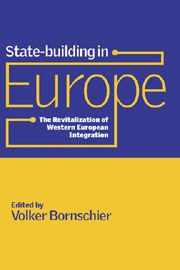Book contents
- Frontmatter
- Contents
- List of figures and tables
- List of contributors
- Preface
- Acknowledgements
- Part I State-building and Political Entrepreneurship
- 1 Western Europe's move toward political union
- 2 Tying up the Luxembourg package of 1985
- Part II The Core Elements in Recasting the European Bargain
- Part III Conclusions beyond the Single European Act of 1986
- Appendix List of interview partners
- Bibliography
- Index
2 - Tying up the Luxembourg package of 1985
Published online by Cambridge University Press: 10 October 2009
- Frontmatter
- Contents
- List of figures and tables
- List of contributors
- Preface
- Acknowledgements
- Part I State-building and Political Entrepreneurship
- 1 Western Europe's move toward political union
- 2 Tying up the Luxembourg package of 1985
- Part II The Core Elements in Recasting the European Bargain
- Part III Conclusions beyond the Single European Act of 1986
- Appendix List of interview partners
- Bibliography
- Index
Summary
‘L'initiative vient toujours d'en haut!’
Frédéric Moreau in Flaubert's Education sentimentaleA considerable part of the debate on the reasons for the integration thrust in the 1980s is based on the not always precise differentiation between statements on the origins of political initiatives, the corresponding agenda setting, the mediation of interests and thus the transformation of the initiative and its adoption. This is shown with the often undifferentiated use of the terms ‘1992 Initiative’, ‘EC reform’, ‘Single European Act’ (SEA), etc. Furthermore, the origins of political initiatives and the prerequisites for their success (or failure) are often imprecisely distinguished from each other. This chapter chronologically and logically follows chapter 1 in that it reconstructs the process of the construction of a successful package deal, the Luxembourg package, by making reference to the analysis of the causal factors of the integration relaunch. The Luxembourg package is hereby defined as the entirety of the agreements on the insertion or amendment of articles in the EC treaties, as they were formulated during the intergovernmental conference in 1985, which together form the Single Act and which were adopted by the Council of Ministers in 1986.
The first section presents some theoretical considerations on the conditions for success of a package deal. The following section describes important integration projects and processes for forming alliances. The first six months in 1984 are seen as the ‘take-off’ phase for the SEA. The Commission's changing role, its actual ‘rebirth’ as a result of an altered situation and as a precondition for the creation of a negotiation package, is then discussed.
- Type
- Chapter
- Information
- State-building in EuropeThe Revitalization of Western European Integration, pp. 38 - 72Publisher: Cambridge University PressPrint publication year: 2000
- 4
- Cited by



